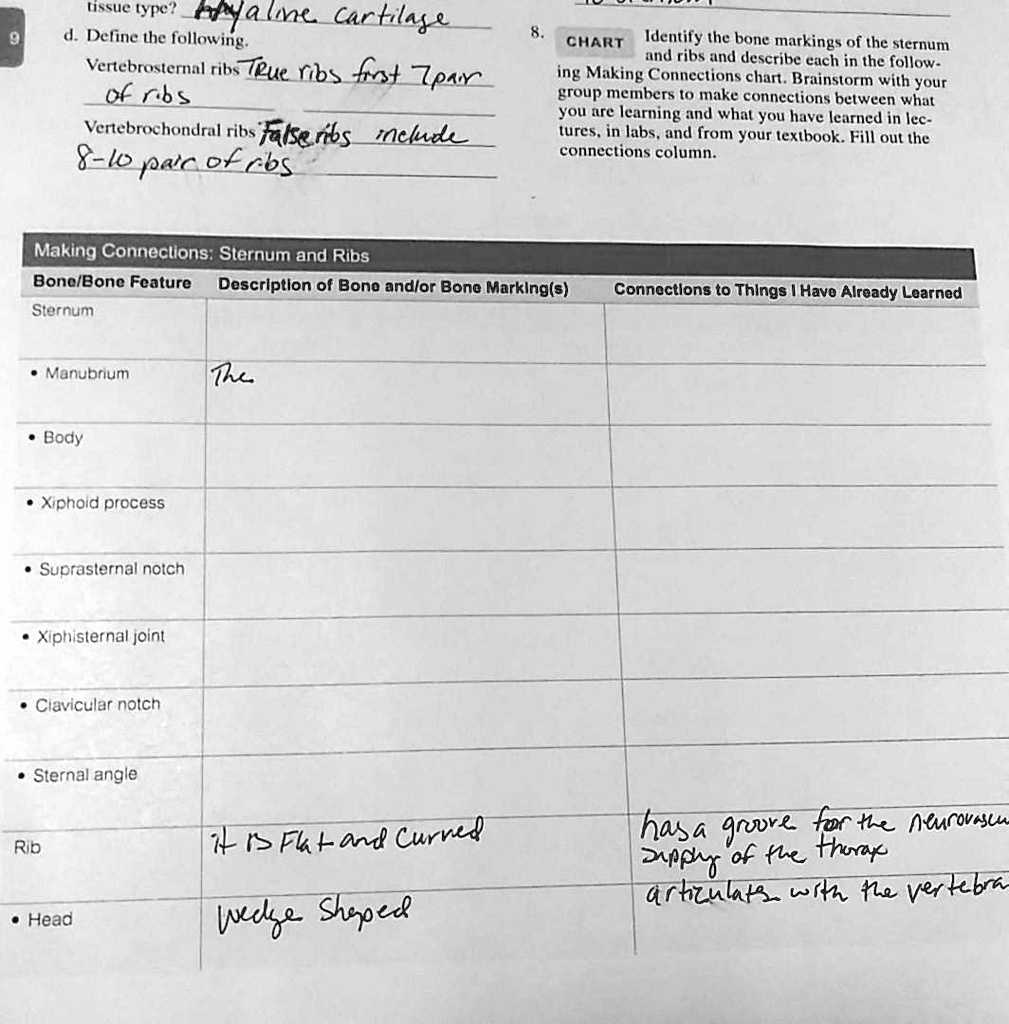tissue type? myalne Carklas& 4. Define the following. Vertebrosternal ribs True ribs first pair of ribs Vertebrochondral ribs False ribs including floating ribs Chart: Identify the bone markings of the sternum and ribs and describe each in the following Making Connections chart. Brainstorm with your group members to make connections between what you’re learning and what you have learned in lectures, labs, and from your textbook. Fill out the connections column. Making Connections: Sternum and Ribs Bone/Bone Feature Description of Bone and/or Bone Marking(s) Sternum Connections to Things I Have Already Learned Manubrium Body Xiphoid process Suprasternal notch Xiphisternal joint Clavicular notch Sternal angle True ribs False ribs Floating ribs

The Correct Answer and Explanation is:
Certainly! Here’s a completed response based on your worksheet and notes:
1. Tissue Type: Hyaline cartilage
2. Definitions:
- Vertebrosternal ribs: Also known as true ribs, these are the first seven pairs of ribs. Each connects directly to the sternum via its own costal cartilage.
- Vertebrochondral ribs: These are ribs 8 to 10. They are called false ribs because they do not connect directly to the sternum. Instead, their cartilages merge with the cartilage of the seventh rib.
- Floating ribs: These are ribs 11 and 12. They are a subset of false ribs that do not connect to the sternum at all.
Making Connections: Sternum and Ribs
| Bone/Bone Feature | Description of Bone and/or Bone Marking(s) | Connections to Things I Have Already Learned |
|---|---|---|
| Manubrium | The broad, upper part of the sternum. Articulates with the clavicles and first pair of ribs. | Similar to the way the atlas supports the skull, the manubrium supports the upper thorax. |
| Body | The elongated central portion of the sternum. Articulates with costal cartilages of ribs 2 to 7. | Like the vertebral body in the spine, it provides structural support and attachment sites. |
| Xiphoid process | The small cartilaginous lower tip of the sternum that ossifies with age. | Comparable to cartilage found in joints, especially at the rib’s costal end. |
| Suprasternal notch | The notch at the superior border of the manubrium between the clavicular articulations. | Similar in surface landmark utility as the iliac crest in pelvic exams. |
| Xiphisternal joint | The articulation between the body of the sternum and the xiphoid process. | Reminiscent of synchondroses seen in long bone growth plates. |
| Clavicular notch | Indentation on either side of the manubrium where it articulates with the clavicle. | Mirrors the acromioclavicular joint connection in shoulder mechanics. |
| Sternal angle | The junction between the manubrium and the body of the sternum. Often used as a landmark for the second rib. | Important in clinical exams like measuring rib space for heart auscultation. |
| True ribs | Ribs 1 through 7. Attach directly to the sternum by their own costal cartilages. | Related to respiratory movements studied in pulmonary mechanics. |
| False ribs | Ribs 8 through 12. Do not attach directly to the sternum. | Their flexibility helps protect underlying abdominal organs without restricting movement. |
| Floating ribs | Ribs 11 and 12. Do not attach to the sternum or to other ribs anteriorly. | Their positioning relates to renal anatomy, as the kidneys are partially shielded by them. |
This chart ties in anatomical structures with physiological function and clinical relevance—something you’ve likely touched on in lectures and labs. Let me know if you’d like a visual summary or mnemonics to help memorize these features.
